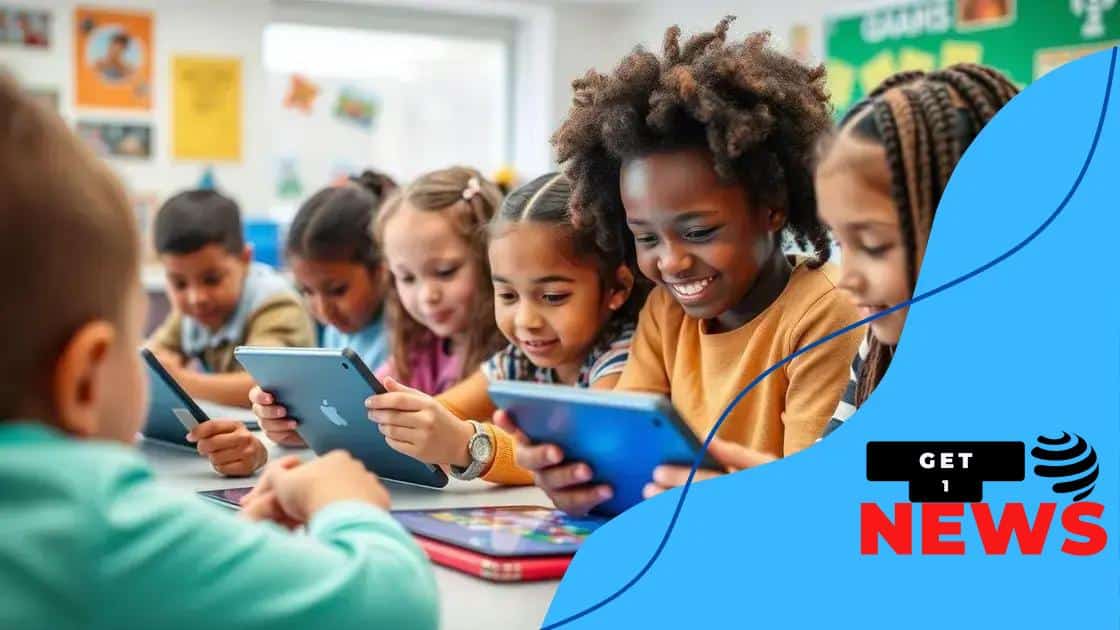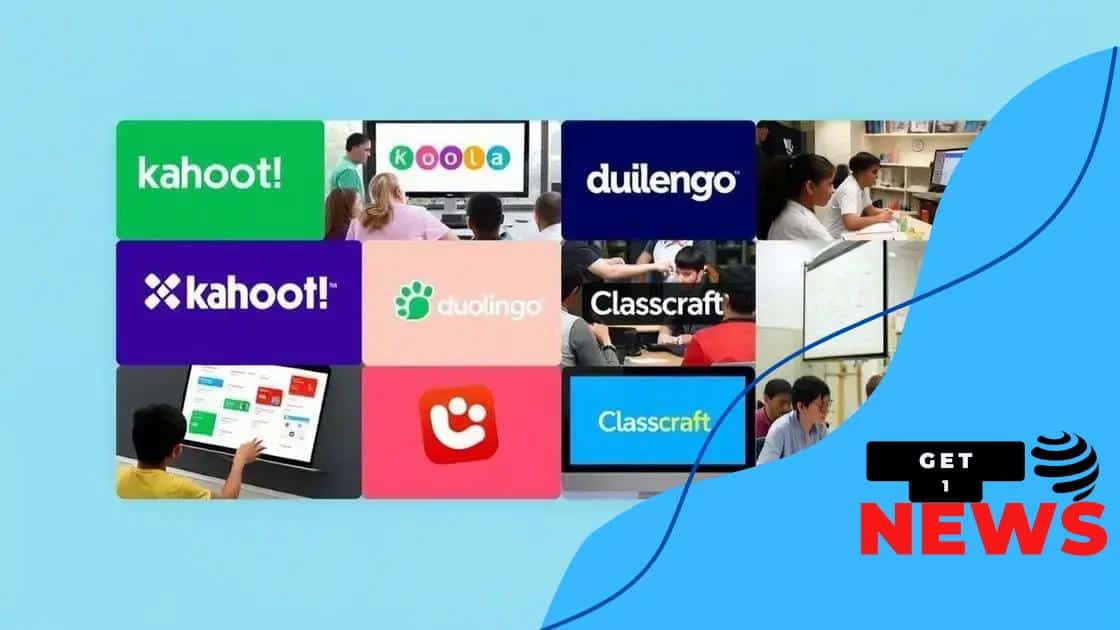Gamified educational platforms: how they enhance learning

Gamified educational platforms leverage game elements like points and badges to enhance student engagement, motivation, and learning retention, while addressing challenges such as technology access and content quality.
Gamified educational platforms are changing the way we learn today. By incorporating game-like elements into educational experiences, these tools make learning more engaging and enjoyable. Have you ever thought about how play can effectively motivate students?
Understanding gamified educational platforms
Understanding gamified educational platforms is essential to grasp how they transform learning experiences. These platforms combine the best of both worlds: education and gaming. This approach not only captures students’ attention but also maintains their motivation to learn.
What are gamified educational platforms?
Gamified educational platforms use game-like elements in non-game contexts. They often integrate features such as point systems, levels, badges, and leaderboards. These elements can motivate learners and create an enjoyable atmosphere.
Key advantages of gamification in education
- Enhanced engagement: Students are more likely to participate actively when learning feels like a game.
- Increased motivation: Rewards and achievements encourage learners to push themselves further.
- Improved retention: The fun and interactive nature of gamified content helps enhance memory and recall.
By presenting the material in an interactive manner, students can grasp complex concepts more easily. For example, a science quiz might have levels where a learner unlocks new topics after mastering each one. Moreover, competition among peers can drive students to strive for better performance. As they engage in co-op tasks or races, the learning experience can become more dynamic and collaborative.
Examples of popular gamified platforms
Many educational platforms utilize gamification techniques effectively. Some of these include:
- Kahoot: A game-based learning platform that allows users to create quizzes.
- Quizizz: Engages learners with fun quizzes and leaderboards.
- Classcraft: Turns the classroom into a role-playing game where students can earn rewards.
These examples show how gamification can be tailored to different subjects and age groups, making learning versatile and enjoyable. Additionally, feedback is instantaneous, which can reinforce positive behaviors.
Key benefits of gamification in learning
Key benefits of gamification in learning offer exciting advantages that can significantly enhance students’ educational experiences. By integrating gaming elements into academic instruction, learning becomes not only more enjoyable but also effective.
Increased Student Engagement
When learning is presented as a game, students are more likely to stay focused and engaged. The competitive aspects and rewards found in games can drive learners to participate actively. For example, students may work harder to earn points or badges, pushing themselves to reach new levels of understanding.
Enhanced Motivation
Gamification taps into the natural desire for achievement. By creating challenges that feel attainable, students are inspired to engage deeply with the material. Additionally, this approach fosters a sense of community as students often collaborate or compete.
- Real-time feedback: Gamified platforms provide immediate feedback, helping students understand their progress.
- Fun learning experience: This method makes education enjoyable, transforming lessons into exciting challenges.
- Development of soft skills: Collaborative games encourage teamwork and communication among students.
As students tackle various challenges, they not only learn the material but also improve essential life skills. The interactive nature of gamified education helps them approach problems creatively and develop critical thinking abilities.
Improved Retention Rates
Gamification can significantly boost memory retention. When students interact with content through games, they are more likely to remember it later. Incorporating elements of fun ensures that lessons stick. The excitement generated by learning through play can lead to longer-lasting knowledge.
Moreover, gamified systems often encourage revisiting content, allowing students to refresh their understanding continually. As learners advance through levels, they reinforce previously learned material, creating a solid foundation for future studies.
Examples of successful gamified platforms

There are many successful gamified platforms that have made a significant impact on education today. These platforms use game elements to enhance learning and engage students effectively. Let’s explore some notable examples that illustrate how gamification can transform educational experiences.
Kahoot!
Kahoot! is a game-based learning platform where teachers create quizzes that students can play in real-time. It encourages friendly competition among students and makes learning interactive. As students answer questions, they earn points and can see their rankings on a leaderboard, which motivates them to improve.
Duolingo
Duolingo is a popular language-learning app that uses gamification to keep users engaged. It offers levels, rewards, and challenges that make learning a new language feel like playing a game. Users earn points (called “XP”) and unlock new lessons as they progress, enhancing their skills in a fun way.
Classcraft
Classcraft transforms the classroom into a role-playing game. Students can choose characters and work together to complete quests. They can earn rewards for positive behavior, which fosters teamwork and motivation. This platform turns traditional educational tasks into exciting adventures.
Quizizz
Quizizz allows teachers to create quizzes that students can answer at their own pace. It features a game-like design where learners can compete against classmates. The feedback is immediate, helping students understand their mistakes while keeping the learning process enjoyable.
- Coding Game: This platform gamifies coding by presenting learners with coding challenges that they must solve to progress.
- Prodigy Math: Prodigy makes math lessons fun through an RPG format where students engage in quests and battles by answering math questions.
- Microsoft’s Minecraft: Education Edition: This platform combines the popular game with educational content, encouraging creativity and collaboration among students.
These examples show the versatility of gamified platforms in different subjects. By making learning entertaining, students are more likely to participate and achieve their educational goals.
Challenges faced by gamified education
Despite the benefits of gamified education, there are several challenges that educators and institutions may face. Understanding these obstacles is crucial for successful implementation.
Technology Limitations
One major challenge is the reliance on technology. Not all students have access to the necessary devices, which can create disparities in learning. Schools may lack the infrastructure to support gamified platforms. This could hinder the effectiveness of gamification in reaching all students equally.
Content Quality
The quality of gamified educational content can vary significantly. If the game elements are not well-designed, they can distract from learning objectives. It’s essential that the educational content aligns with the game mechanics to ensure that students grasp the necessary concepts.
Resistance from Educators
Some educators may be resistant to adopting new teaching methods. They might find it challenging to integrate games into their lesson plans or believe that traditional methods are more effective. This resistance can slow down the adoption of gamification strategies.
- Training Needs: Teachers require training and support to effectively use gamified platforms.
- Time Constraints: Curricular demands may limit the time available to implement gamified strategies.
- Assessment Challenges: Grading and assessing students’ learning through games can be complex.
Moreover, students’ varying levels of motivation can impact how they engage with gamified content. While some may thrive on competition and rewards, others may feel overwhelmed or disengaged by the gaming aspects. Striking the right balance is crucial.
Balancing Fun and Learning
Another challenge is finding the right balance between fun and educational value. If gamification leans too much toward entertainment, the educational purpose may be lost. It’s important to maintain a focus on learning outcomes while keeping the experience enjoyable for students.
Future trends in gamified learning environments
The future of gamified learning environments holds exciting possibilities that could reshape education as we know it. With advancements in technology and pedagogy, educators are exploring new ways to engage students.
Integration of Virtual Reality (VR)
One significant trend is the integration of virtual reality (VR) in gamified education. VR allows students to immerse themselves in different worlds where they can interact with the material in a realistic way. For example, students could explore ancient civilizations or conduct science experiments in a lab without ever leaving the classroom.
Increased Personalization
Another trend is the move towards personalized learning experiences. Gamified platforms are starting to use data analytics to tailor educational content based on individual students’ strengths and weaknesses. This means students can progress at their own pace, receiving challenges that are suited to their skill levels.
- Adaptive Learning: Systems that adapt in real-time to a student’s performance will become common.
- Student-Centered Design: More resources will focus on student input to create engaging gamified experiences.
- AI Assistance: Artificial intelligence will aid in creating intelligent tutoring systems that provide feedback and support.
As technology advances, gamification is likely to incorporate more interactive features like simulations and branching scenarios. These immersive experiences can deepen understanding and enhance skills through practice. The increasing use of gamification could help in bridging the gap between education and real-world applications.
Community and Collaboration
Future gamified platforms may also focus more on fostering community and collaboration among students. Online communities can facilitate teamwork, allowing students to tackle challenges together. This collaborative environment encourages communication and helps develop teamwork skills that are valuable in the workforce.
In conclusion, gamified educational platforms represent a revolution in learning that combines fun with educational value. These innovative approaches not only engage students but also enhance motivation and knowledge retention. Despite facing challenges like technology access and content quality, the future of gamification in education is bright. With advancements such as virtual reality and personalized learning, students are set to thrive in dynamic, collaborative, and interactive environments. Embracing these trends will help create better educational experiences for all learners.
FAQ – Frequently Asked Questions about Gamified Educational Platforms
What are gamified educational platforms?
Gamified educational platforms use game-like elements to engage students and enhance the learning experience. They often include points, badges, and challenges.
How do gamified platforms increase student motivation?
By incorporating rewards and competitive elements, gamified platforms encourage students to actively participate in their learning, making it more enjoyable.
What challenges do educators face with gamification?
Educators may encounter challenges such as technology access, content quality, and resistance to adopting new teaching methods.
What is the future of gamified learning?
The future includes trends like virtual reality integration, increased personalization of content, and enhanced community collaboration among students.





